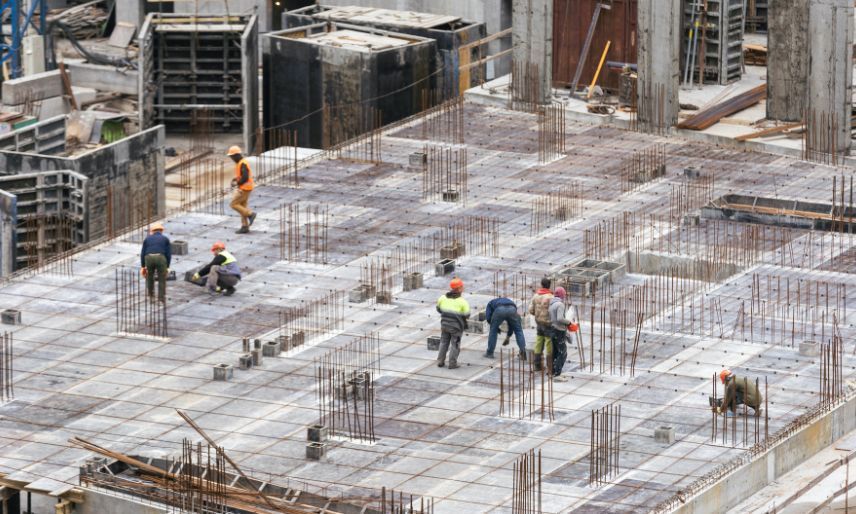Aggregate Bonding Capacity: What is it and How is it Calculated?

In the realm of construction and civil engineering, understanding the properties of materials is crucial for ensuring the durability and integrity of structures. One such property is the aggregate bonding capacity, a fundamental aspect that influences the performance of concrete and other composite materials. This article delves into what aggregate bonding capacity is, its significance, and the methodologies used to calculate it.
Understanding Aggregate Bonding Capacity
Aggregate bonding capacity refers to the ability of aggregates—such as sand, gravel, or crushed stone—to adhere to one another and to the cement paste in concrete. This bonding is essential for achieving the desired strength and durability of concrete structures. A strong bond between aggregates ensures that the concrete can withstand various stresses and environmental conditions over time.
The Importance of Aggregate Bonding
The bonding capacity of aggregates plays a pivotal role in determining the mechanical properties of concrete. When aggregates bond effectively, they help distribute loads evenly throughout the structure, minimizing the risk of cracking and failure. Additionally, strong bonding can enhance the resistance of concrete to weathering, freeze-thaw cycles, and chemical attacks, thereby prolonging the life of the structure.
Moreover, understanding aggregate bonding capacity can aid engineers and architects in selecting the right materials for specific applications. For instance, in high-performance concrete used for bridges or high-rise buildings, the bonding capacity must be maximized to ensure safety and longevity. In such cases, engineers often conduct extensive testing to evaluate the bonding properties of different aggregate types, which can lead to innovative solutions tailored to specific environmental challenges.
Factors Influencing Aggregate Bonding Capacity
Several factors influence the bonding capacity of aggregates, including:
- Surface Texture: Rougher surfaces tend to provide better mechanical interlock, enhancing bonding.
- Particle Size: The gradation of aggregate particles can affect the packing density and, consequently, the bonding strength.
- Moisture Content: The presence of water can either aid or hinder bonding, depending on the conditions during mixing and curing.
Understanding these factors is essential for optimizing concrete mixes and ensuring that the final product meets the required specifications. Additionally, the chemical composition of the aggregates can also play a significant role in bonding capacity. For example, certain types of aggregates with high silica content may react differently with cement paste compared to those with more calcium-rich compositions, potentially affecting the overall strength and durability of the concrete.
Furthermore, the method of mixing and curing concrete can influence aggregate bonding. Techniques such as using superplasticizers can improve workability and enhance the distribution of aggregates within the mix, leading to better bonding. Similarly, the curing environment—whether it's hot, cold, or humid—can affect the hydration process of cement, which is crucial for achieving optimal bonding. Engineers must consider these variables during the design phase to ensure that the concrete performs as intended under various conditions.
Methods of Calculating Aggregate Bonding Capacity
Calculating aggregate bonding capacity involves various methods, each with its own set of procedures and equipment. These methods can be broadly categorized into experimental and theoretical approaches. Below are some commonly used techniques for assessing bonding capacity.
Experimental Methods
Experimental methods typically involve laboratory testing where samples of concrete are subjected to specific conditions to evaluate their bonding strength. Some popular tests include:
- Pull-Out Test: This method measures the force required to pull an embedded anchor from the concrete. The results provide insights into the bonding strength of the aggregate.
- Shear Test: This test evaluates the shear strength of the bond between aggregates and the cement paste, giving a direct measure of bonding capacity.
- Flexural Strength Test: By examining the flexural strength of concrete beams, one can infer the effectiveness of aggregate bonding.
These tests are crucial for quality control in concrete production and help ensure that the materials used meet the necessary standards. Additionally, the results from these experimental methods can be influenced by factors such as aggregate grading, moisture content, and the presence of additives, making it essential to conduct tests under controlled conditions. The variability in results can also provide insights into the long-term durability of concrete structures, as understanding bonding capacity is vital for predicting how well a concrete mix will perform over time.
Theoretical Approaches
Theoretical approaches often involve mathematical models and simulations to predict bonding capacity based on material properties and environmental conditions. Some of the key theoretical methods include:
- Empirical Formulas: Various empirical equations can estimate bonding strength based on aggregate size, shape, and surface characteristics.
- Finite Element Analysis (FEA): This computational method simulates the behavior of concrete under different loading conditions, allowing for a detailed analysis of bonding capacity.
- Microstructural Modeling: By examining the microstructure of concrete, researchers can better understand how aggregate particles interact and bond with the cement matrix.
Theoretical approaches complement experimental methods, providing a comprehensive understanding of aggregate bonding capacity. They allow engineers to predict how changes in material composition or environmental factors, such as temperature and humidity, can affect the overall performance of concrete. Furthermore, advancements in computational power have made it possible to conduct more complex simulations that can account for real-world conditions, leading to more accurate predictions and better design practices. This synergy between theoretical and experimental methods not only enhances the reliability of bonding capacity assessments but also drives innovation in concrete technology.
Applications of Aggregate Bonding Capacity
Understanding and calculating aggregate bonding capacity has significant implications across various sectors of construction and engineering. The insights gained from bonding capacity assessments can lead to better material selection, improved construction practices, and enhanced structural performance. This understanding is not only vital for the integrity of the structures but also plays a key role in sustainability efforts, as optimized materials can lead to reduced waste and lower environmental impact.
Infrastructure Development
In infrastructure projects such as highways, bridges, and tunnels, the bonding capacity of aggregates is critical. Engineers must ensure that the concrete used can withstand heavy loads and environmental stresses. By optimizing aggregate bonding, projects can achieve greater longevity and safety, reducing maintenance costs over time. Furthermore, the use of high-bonding aggregates can enhance resistance to freeze-thaw cycles and chemical attacks, which are common in regions with harsh weather conditions. This not only extends the lifespan of the infrastructure but also minimizes the need for frequent repairs, ultimately saving taxpayer money and resources.
Residential and Commercial Construction
For residential and commercial buildings, the bonding capacity of aggregates influences the overall quality of concrete used in foundations, walls, and pavements. A strong bond ensures that structures can resist cracking and other forms of deterioration, providing safety and comfort for occupants. Additionally, the aesthetic appeal of concrete finishes can be significantly enhanced by selecting aggregates with optimal bonding properties. This can lead to more visually striking designs, as well as improved performance characteristics, such as increased durability against wear and tear from foot traffic or vehicular loads. Moreover, the integration of advanced bonding agents can further enhance the performance of concrete, making it a versatile choice for modern construction needs.
Specialty Concrete Applications
In specialty applications, such as precast concrete elements or high-performance concrete for extreme environments, understanding aggregate bonding capacity becomes even more crucial. Engineers can tailor concrete mixes to meet specific performance criteria, ensuring that the final product is suitable for its intended use. For instance, in marine environments, where concrete is exposed to saltwater, selecting aggregates with superior bonding characteristics can significantly reduce the risk of corrosion and structural failure. Similarly, in areas prone to seismic activity, optimizing the bonding capacity can enhance the ductility and resilience of concrete structures, allowing them to better withstand the forces of an earthquake. This level of customization not only meets regulatory requirements but also addresses the unique challenges posed by specific environmental conditions, ultimately leading to safer and more reliable construction outcomes.
Challenges in Assessing Aggregate Bonding Capacity
While assessing aggregate bonding capacity is essential, several challenges can complicate the process. These challenges can arise from the variability of materials, environmental conditions, and testing methodologies.
Material Variability
Aggregates can vary significantly in terms of size, shape, and surface texture, which can affect bonding capacity. This variability makes it challenging to establish standardized testing methods that accurately reflect real-world conditions. Engineers must account for these differences when interpreting test results. For instance, angular aggregates may provide better interlocking and mechanical bonding compared to rounded aggregates, which can lead to discrepancies in performance. Additionally, the presence of impurities or coatings on aggregate particles can further complicate bonding, necessitating thorough material characterization to ensure reliable assessments.
Environmental Factors
Environmental conditions, such as temperature and humidity, can influence the bonding process during mixing and curing. For instance, high temperatures can lead to rapid evaporation of water, affecting the hydration process and, consequently, the bonding capacity. Conversely, low temperatures can slow down chemical reactions, potentially delaying the setting time and impacting the overall strength of the material. Understanding these factors is crucial for accurate assessments. Moreover, seasonal variations can introduce further complications, as the performance of bonding agents may differ significantly between summer and winter conditions. This variability underscores the need for adaptive strategies in construction practices to mitigate the effects of environmental fluctuations.
Testing Limitations
Each testing method has its limitations, and no single test can provide a complete picture of aggregate bonding capacity. For example, while pull-out tests provide valuable data, they may not fully account for the complex interactions between aggregates and cement paste in real-world applications. Therefore, a combination of methods is often necessary for a comprehensive evaluation. Additionally, the scale of testing can also pose challenges; laboratory results may not always translate directly to field performance due to differences in scale and application techniques. This discrepancy highlights the importance of field testing and monitoring to validate laboratory findings, ensuring that the bonding capacity assessments are both accurate and applicable to actual construction scenarios.
Future Trends in Aggregate Bonding Capacity Research
Research into innovative materials, such as recycled aggregates and bio-based binders, is gaining traction. These materials often exhibit different bonding characteristics compared to traditional aggregates, necessitating new approaches to assess their bonding capacity effectively. Understanding how these materials behave in concrete can lead to more sustainable construction practices. For instance, the use of recycled aggregates not only reduces waste but also lowers the carbon footprint associated with the extraction and processing of natural aggregates. Studies have shown that when properly treated, recycled aggregates can achieve comparable bonding strength to virgin materials, making them a viable option for various construction applications.
Advanced Testing Techniques
Emerging technologies, such as digital imaging and machine learning, are being explored to enhance testing methodologies. These advanced techniques can provide more accurate and detailed insights into the bonding process at a microscopic level, leading to better predictions of concrete performance. For example, digital imaging can reveal the intricate interfaces between aggregates and the cement matrix, allowing researchers to identify potential weaknesses or areas for improvement. Machine learning algorithms can analyze vast datasets from these tests, uncovering patterns that may not be immediately apparent through traditional analysis. This integration of technology not only streamlines the research process but also accelerates the development of more effective bonding materials.
Sustainability Considerations
As sustainability becomes a priority in construction, understanding the environmental impact of materials used is crucial. Research into the bonding capacity of eco-friendly aggregates and their performance in concrete can help promote greener construction practices while ensuring structural integrity. Moreover, the exploration of alternative binding agents, such as those derived from agricultural byproducts, is gaining momentum. These bio-based options not only improve the sustainability profile of concrete but can also enhance its durability and resistance to environmental stressors. By focusing on sustainable practices, the construction industry can contribute to a circular economy, where materials are reused and recycled, minimizing waste and conserving resources.
Conclusion
Aggregate bonding capacity is a vital aspect of concrete performance that influences the durability and integrity of structures. Understanding what it is and how it is calculated can significantly impact the construction industry, leading to safer and more sustainable practices. By considering the factors that affect bonding capacity, utilizing both experimental and theoretical methods, and staying abreast of emerging trends, engineers and construction professionals can optimize their materials and methods for better outcomes.
As the industry continues to evolve, ongoing research and innovation will play a crucial role in enhancing our understanding of aggregate bonding capacity, ultimately leading to improved construction practices and more resilient structures.



